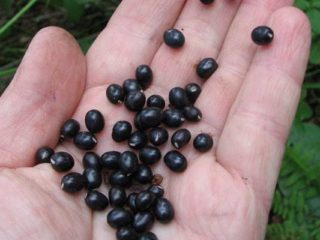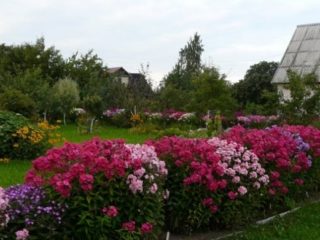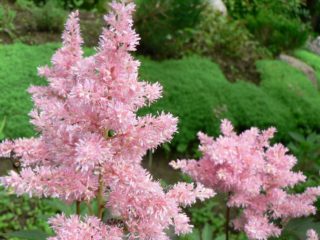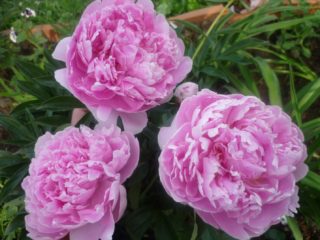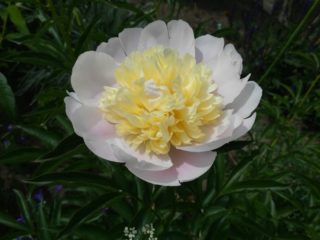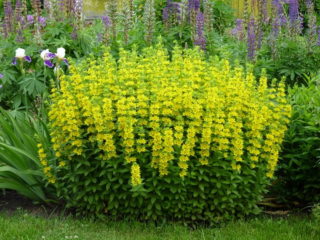Content
The rose does not bloom mainly due to improper care. But there are reasons related to the weather or the characteristics of the variety. To eliminate the problem, you need to accurately diagnose the factor that affected the flowering and take appropriate measures, for example, regulate watering or carry out pest control.
Why does a rose not bloom, but bush?
The reasons why a rose bush does not bloom are very different. In many cases, they are associated with improper care and violation of planting rules. Although there are also objective factors, for example, age characteristics or unfavorable weather. The most common causes are detailed in the following sections.
Age characteristics
If a young rose does not bloom, this may be due to age characteristics. For example, in the first year of life or after planting, the plant does not produce buds, which is quite normal, and this does not depend on the specific variety. The seedlings must take root in the new place, they take root and release nutrients to produce green mass.
Different seedlings are very different from each other.For example, if they spent the entire winter period in the cellar or refrigerator, then the entire season after planting they will recover from stress. But it also happens that they grew in a pot at home and even produced buds. Such roses may well bloom the first season after planting. But this is undesirable - it is better to cut off the buds and wait until next summer.
There are also varieties such as, for example, the climbing rose Rambler. It does not bloom on the shoots of the current year. Buds appear only on the branches of the next season, provided that the wintering went well.
If a bush rose does not bloom, the reason may be due to the fact that the branches and bushes are too old. This is especially noticeable by the woody, thin brown bark. When pruning, it is better to leave young green shoots that bend well and do not break.
Error when choosing a landing site
If roses do not bloom, but grow strongly and gain green mass well, the reason is most likely due to the wrong place for planting. Each variety has its own requirements, but all pinks need good lighting. If the area is covered by the shadow of a building, tall bush or tree, it will be able to grow, but the buds will not open.
Another reason why a rose does not bloom is due to the fact that the plants do not tolerate draft winds well. Therefore, it is better to choose a place protected from air currents, especially on the north side of the garden.
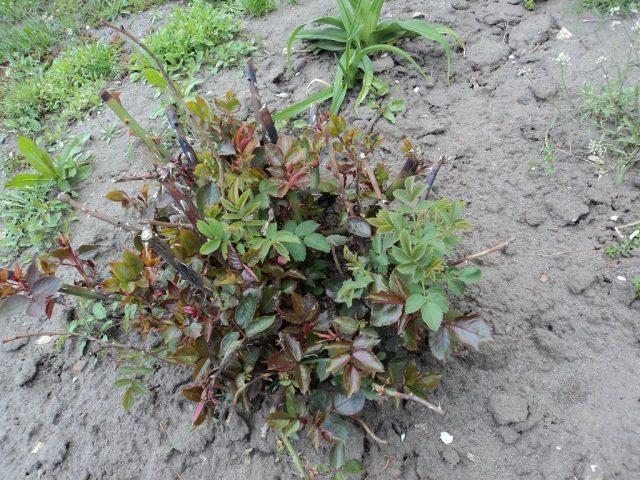
The bush may stop blooming due to shade or strong wind
It is also undesirable to choose lowlands where water constantly accumulates from rain, snow, and after irrigation. Areas where the groundwater is too high are also undesirable.
Unsuitable soil
Flowers are quite demanding on the composition of the soil. If, for example, a park rose does not bloom, this indicates very depleted soil, because this crop is not too whimsical. And many other ornamental varieties may not produce buds even on relatively good soil. Therefore, it is important to pre-fertilize the soil and also ensure normal pH (acidity indicator).
It should be remembered that roses, like most other flowers, grow normally in a slightly acidic environment with a pH of 5.5 to 6.5. If you are not sure, it is recommended to first measure it using indicator paper or a pH meter.
Root growth
If a rose does not bloom in the garden, the reason may be related to root shoots. A few years after planting, young shoots appear in large quantities around the main stem. These are shoots that come from the rootstock (rose hips are often used for these purposes). At the same time, some gardeners believe that there is no need to touch the shoots and expect the bush to produce buds.
But time passes, the rose does not bloom, and this is due precisely to the shoots. The fact is that new cuttings grow rapidly and take away water and nutrients that the main bush lacks. Therefore, such growth should be carefully removed.
Improper watering
If a rose does not bloom, this may be due to violation of watering rules. Water should not be given too often, but in large quantities. It should wet the surface layer of soil and reach the roots.After this, the soil must be loosened so that it does not compact. Thanks to this, the root system will receive not only water, but also access to air.
During drought, you should water the rose more often, because otherwise it will not bloom. It should not be allowed to get to the point where the soil is completely dry, much less cracking. Even if inflorescences appear, they will be small. If you water well, there will be noticeably more flowers.
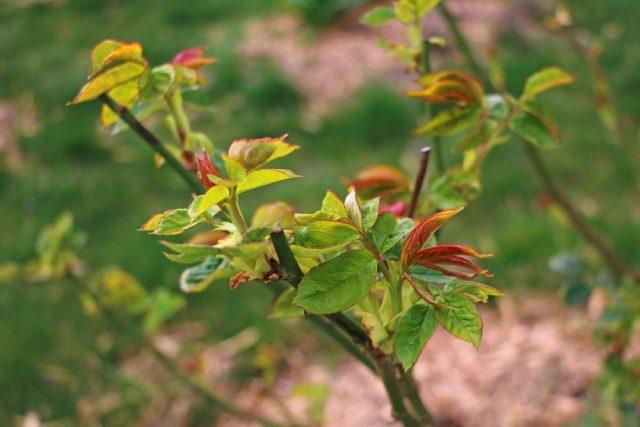
If watering is irregular, the rose will also stop blooming.
Errors when feeding
When a rose does not bloom, and the place is sunny, the soil is good enough, watering is regular, the reason may be due to improper feeding. Fertilizers must be given regularly and strictly in accordance with the instructions. Experienced gardeners have long noticed that overfeeding is even worse than underfeeding.
This is especially true for nitrogen fertilizers, which stimulate the growth of green mass, but do not promote flowering. The composition of fertilizers must be balanced. It is necessary to strictly observe both the quantity and the rules of application (timing, methods - root or leaf).
It is recommended to periodically inspect the bushes. If the rose does not bloom, and the leaves begin to turn yellow (they acquire a bluish tint below), this indicates a lack of nitrogen. If the buds do not set, there is a sharp stop in development, the leaves acquire shades of purple, the reason is a lack of phosphorus. If the foliage turns yellow, the rose does not bloom, and “burns” of a dark shade appear on the surface, this indicates a lack of potassium.
Incorrect pruning
It also happens that a rose grows upward and does not bloom. In this case, the most likely cause is improper pruning. As already mentioned, some varieties bloom on next year's shoots.Therefore, you should not remove branches that appeared this season. In addition, the bushes need to be periodically pruned for rejuvenation. Old branches aged 3-4 years and older are removed.
Freezing
If roses do not bloom in the spring or summer, and the care is good enough, the place is well lit and the soil is fertile, this may certainly be due to a too harsh winter. It is difficult to influence this, but it is necessary to at least protect the bush in the fall. To do this, mulch is carried out, covered with agrofibre, and cones made of polystyrene foam or other materials are used.
Pests or diseases
If a tea rose does not bloom, the reason may be due to diseases and pests. Among the most dangerous pathologies are fungal, viral and bacterial infections:
- spotting;
- mosaic;
- gray rot;
- powdery mildew;
- bacteriosis
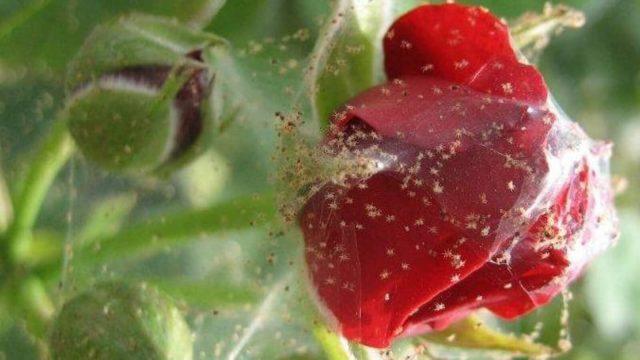
Signs of a spider mite infestation
Of the insects that are especially dangerous:
- thrips;
- scale insects;
- spider mites;
- leaf rollers;
- aphid;
- rose sawfly.
What to do if roses don't bloom well
If a rose does not bloom, you first need to determine the reason. To do this, you should analyze the situation for each point described above. Next, you need to inspect the bush for signs of nutrient deficiency (yellowing, darkening of leaves), diseases, and insect infestations.
If none are found, it is recommended to analyze the pH of the soil using an appropriate device or indicator paper. Next you need to pay attention to care - how moist and loose the soil is.
If the reason is related to an unsuitable location, the bushes are dug up (preferably in September) and replanted. The site must meet several requirements:
- fertile and light soil - loamy, sandy loam with pH 5.5-6.5;
- absence of stagnant water (lowlands are not considered) and strong drafts;
- openness, illumination;
- without close proximity to lilacs, large shrubs and trees.
After planting, it is necessary to provide normal care. Since roses often do not bloom due to irregular watering, water is given weekly, or every three days during drought. An adult bush requires two buckets of water. Moreover, it should not be cold, but settled, at room temperature.
Fertilizers are given to plants at least three times per season. In April, the emphasis is on urea, ammonium nitrate (20 g per 10 l) and other nitrogen compounds. During the formation of buds, superphosphate (40 g) and potassium sulfate (30 g) are added. After another 2-3 weeks they give the same composition. You can also use special complex fertilizers, as well as organic matter (mullein, potassium humate).
The soil is periodically loosened and weeds are removed. To keep it moist longer, lay dry hay, straw and other mulch. Every spring, old, weakened branches are removed (before the buds begin to swell). If the rose does not bloom and the bush is old, rejuvenating pruning should be done in the fall. In spring and summer, the growth is carefully removed - and it must not only be trimmed, but even the stumps must be removed.
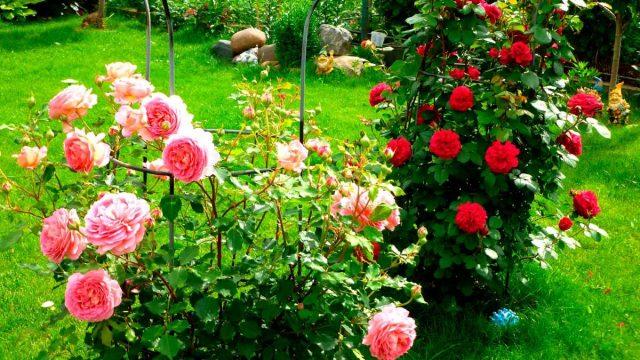
For roses to bloom, they need to be regularly watered, fed and covered for the winter.
For the winter, the bushes are mulched again. After pruning, they are covered with agrofibre, covered with hay, sawdust, and spruce branches. In the regions of the Urals, Siberia, and the Far East, insulation must be especially thorough. Every spring, preventive treatment is carried out with fungicides (Maxim, Skor, Bordeaux mixture and others). If necessary, spray with insecticides.
Conclusion
The rose does not bloom for various reasons.They are often associated with the wrong choice of location, improper watering, fertilizing, or lack of pruning. Plants are quite demanding, so you need to take good care of them. Then the flowering will be lush and abundant.

